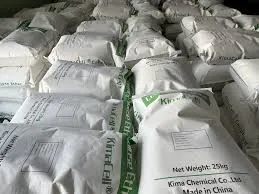
Oct . 13, 2024 04:43 Back to list
Safety Data Sheet Overview for Hydroxyethyl Cellulose in Industrial Applications
Understanding Hydroxyethyl Cellulose (HEC) and its Safety Data Sheet (SDS)
Hydroxyethyl cellulose (HEC) is a water-soluble polymer derived from cellulose, a natural biopolymer. Due to its unique properties, including thickening, gelling, and film-forming abilities, HEC is widely used in various industries such as pharmaceuticals, cosmetics, food, and construction. As with any chemical substance, it is essential to understand its safety, handling, and potential hazards, which is why Safety Data Sheets (SDS) play a crucial role in ensuring safe usage.
Properties of Hydroxyethyl Cellulose
HEC is produced through the etherification of cellulose with ethylene oxide, yielding a product with varying degrees of substitution. The resulting polymer is non-ionic and is characterized by its high viscosity even at low concentrations. HEC is available in different grades, which vary in molecular weight and viscosity, allowing for versatile applications depending on the specific requirements of a formulation.
In the pharmaceutical industry, HEC is often used as a binder in tablets, a thickening agent in gels, and a stabilizer in emulsions. In cosmetics, it is frequently found in lotions and creams for its ability to improve texture and provide a smooth, consistent feel on the skin. Additionally, HEC is utilized in food products as a thickener and stabilizer, contributing to the desired consistency and shelf stability. In construction, HEC is used in cement formulations and tile adhesives to enhance workability and water retention.
Safety Data Sheet (SDS) Overview
An SDS is a document that provides detailed information about a substance, including its hazards, handling and storage guidelines, and emergency response measures. For HEC, the SDS is essential for ensuring safe usage in various applications. Every user of HEC should familiarize themselves with its SDS, which includes several key sections
1. Identification This section includes the name of the substance, recommended uses, and contact information for the supplier. It serves as the initial point of reference for understanding what HEC is and its intended applications.
2. Hazard Identification HEC is generally considered to have low toxicity and is not classified as a hazardous substance. However, potential hazards may arise during production, handling, or in cases of exposure. The SDS outlines possible health effects, including skin and eye irritation in sensitive individuals. This information is crucial for workers to implement necessary precautions.
hydroxyethyl cellulose sds

3. Composition/Information on Ingredients This section details the chemical composition of HEC, including its CAS number. Understanding the components of HEC helps in evaluating the safety and compatibility of the substance with other materials.
4. First-Aid Measures In case of accidental exposure, this section provides guidance on immediate first-aid procedures. For HEC, if ingested or if it comes into contact with skin or eyes, the SDS recommends rinsing with water and seeking medical attention as necessary.
5. Handling and Storage Proper handling and storage practices are critical for maintaining the integrity of HEC. The SDS advises users to keep HEC in a cool, dry place away from incompatible materials. It also recommends using personal protective equipment (PPE) when handling HEC, especially in powdered form, to prevent inhalation.
6. Accidental Release Measures In case of spills, the SDS outlines appropriate clean-up procedures. Since HEC is water-soluble, spills should be contained, and the area cleaned up immediately to prevent any slip hazards.
7. Toxicological Information This section provides data on the potential health effects of HEC, including routes of exposure and symptoms associated with overexposure. Again, HEC is generally considered non-toxic, but precautions are always recommended.
8. Ecological Information Understanding the environmental impact of substances like HEC is increasingly important. The SDS includes information on the biodegradability of HEC and its potential effects on aquatic life, ensuring that users are aware of its environmental profile.
Conclusion
Hydroxyethyl cellulose is a valuable compound used across various industries due to its thickening, binding, and stabilizing properties. However, like any chemical product, safe handling and awareness of its properties are crucial. The Safety Data Sheet for HEC provides vital information that helps users understand potential hazards and safe practices for handling. By adhering to these guidelines, industries can effectively utilize HEC while ensuring the safety of their workers and the environment.
-
Versatile Hpmc Uses in Different Industries
NewsJun.19,2025
-
Redispersible Powder's Role in Enhancing Durability of Construction Products
NewsJun.19,2025
-
Hydroxyethyl Cellulose Applications Driving Green Industrial Processes
NewsJun.19,2025
-
Exploring Different Redispersible Polymer Powder
NewsJun.19,2025
-
Choosing the Right Mortar Bonding Agent
NewsJun.19,2025
-
Applications and Significance of China Hpmc in Modern Industries
NewsJun.19,2025







